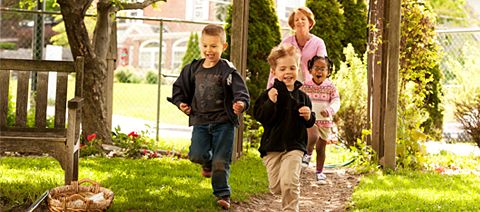Natural Play in the Preschool Yard
| January 2013Imagine a circle of 15" high logs, tops flattened, spaced just so a four-year-old can leap from one to the next, and if she tumbles, the ground is close. Sometimes the new walkers lay claim to the circle because the logs are just right for cruising. Another time, the threes cluster in the circle to listen to the book their teacher is reading. Later, the space becomes a home where cooking, dishwashing, and important discussions and events occur.
Fortunately the play yard has an abundance of shrubs and trees to provide leaves, twigs, nuts, blossoms, and berries for cooking. This summer, wonderfully enough, the blueberry bushes had berries one could really eat (and wonder why after a few weeks the bushes have no more)! This fall the big oak tree provided an abundance of acorns, perfect for stirring into soup, mixing into salads and making hats for fingers. In the spring, someone will find a tiny new tree poking out of the leaf litter—what a surprise! That is what was inside the hard little acorn? There were so many acorns, what happened to all the rest? Did something eat them?
The squirrels that frequent the play yard ran away with some acorns. Could they have taken so many and where did they put them? Shall we spread out a blanket near the oak tree so we can lie down and look up to see if squirrels are there? Look how tall this tree is. (In the spring the marvel of the tiny acorn sprout and the huge tree will become clear.) Look how we can see all the way through to the sky today—almost no leaves are left. Big clouds today too. Anyone see that hole up there in the trunk? Think someone lives there?
Being under the tall tree could make a person think about being tall. How about running to the top of the hill and looking around; how about climbing on the big rocks and balancing up there? The rocks feel rough and cold but everyone knows where the places for feet and hands are—up to the top! And leap down, an arms-flying superhero! Hey, those kids on the big old logs over there, they might be having trouble in the rough waves. To the rescue! Now let's make this a bus; I'm the driver, we're going to New York!
Simple natural items with all their variability offer children an environment for both imaginative play and learning basic concepts about the biological and physical world. Life cycles, plant growth and development, plant parts, various species noticed and memorized because they are useful for play, seasons, animal habitats and habits—all these concepts and more are available in a play yard like the one described here. The physical world has rocks that the body observes, has hills that the body feels both going up and coming down, and offers different perspectives in different places. Lying on your back on the ground lets one take the measure of a tree, the color of the sky, the movement of the wind seen in the clouds and treetops. It facilitates inquiry such as: how high is the sky? and why can’t we see the stars? Lying on the ground lets a child feel how solid it is too, and how safe.
Unpaved, uncovered ground is especially interesting to children. A sand pit or area, and a dirt digging hole are only difficult for parents and teachers. Froebel, the "father of kindergarten," had to persuade parents that dirt digging was valuable to children. One of his followers wrote that children's instinct to dig was as strong as their instinct to move. Children are like the ancient Greek strongman Antaeus who was strong only when he was touching the ground. "The children renew their strength at the touch of Mother Earth, and yet we arbitrarily hold them back from this storehouse of power."* Isn't it odd with today's automatic washers and driers and no shortage of stain removers and detergents, that parents continue to resist ground play?
Since it is the top layer of the Earth that supports all life, it is important for children to experience it first hand—it provides basic knowledge, biological and physical.
Another natural plaything is sticks, which are also resisted by some teachers and parents. Sticks are linked with our evolution—as a species we have used them as tools to dig roots, plant seeds, thresh grains, fend off enemies, fuel fires, catch fish, build shelters, and for countless other uses. Children are drawn to gather and use sticks. Sticks are part of their natural inheritance. Rules for use are needed of course, just as for scissors and everything else.
The splendid aspect of natural play things is their availability. Sticks fall off trees with regularity. Digging holes are always possible even if some patch of asphalt needs to be removed. Sand is almost as easy to provide—with a big enough yard not even a box is needed. Logs and stumps can come from storm-downed trees; often a parent or a groundskeeper with a chain saw can shape them. Big climbing rocks or boulders can be harder or more expensive to find. Be a scavenger—look at construction sites and become a beggar for children! Plants—try grants for rain gardens. Lots of companies want to give children's yards more nature components. After all, children who grow up loving plants become grownups who like plants.
Children who grow up playing in nature with its treasures will become better stewards of the earth. Nature play is good for children. Perhaps Robert Louis Stevenson said it best more than a century ago:
Happy hearts and happy faces,
Happy play in grassy places--
That was how in ancient ages,
Children grew to kings and sages.**
References:
*Nora Archbold Smith (1896) The Republic of Play. Accessed October 7, 2012 at http://www.archive.org/stream/froebelsoccupationswiggrich_djvu.txtt.
** Robert Louis Stevenson (1885/1952). A Child's Garden of Verses. Harmondworth, Middlesex, England: Puffin Edition, Penguin Books.







